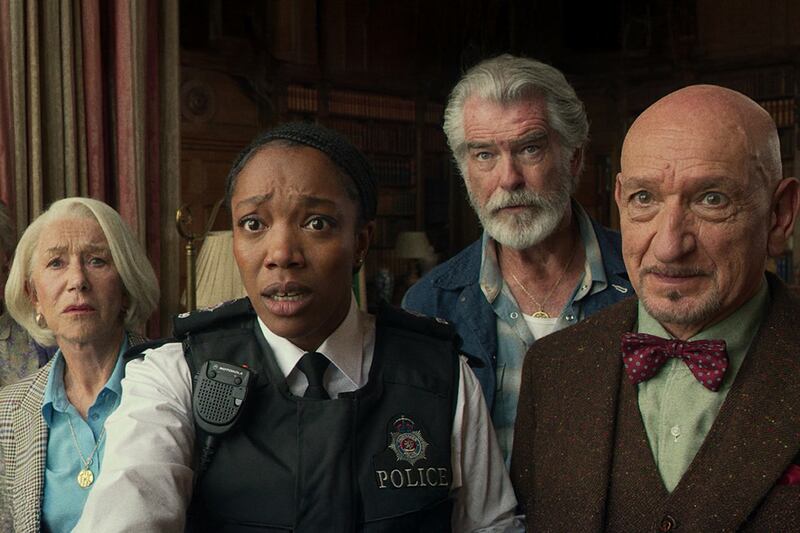The Netflix documentary has become its own genre, and one whose tropes are recognisable at a glance.
They include the introductory quotes along the lines of “We were a typical all-American family” or “March 3rd, 1996, began like any other day”; the opening flash-forward to the story’s climax quickly that segues into a trip back in time to the story’s beginning; the establishing shots of interviewees preparing to be recorded, always adjusting mics or sipping water as the camera pulls focus; and drone footage of suburban landscapes overlaid with the placenames in huge block capitals.
There are also – always, always, always – more episodes than are remotely necessary to tell the story, resulting in the grievous bloat that must help satisfy Netflix’s viewership metrics.
None of these is a novel observation, of course. People have bemoaned the cookie-cutter aesthetic of such documentaries for years. For so long, in fact, that it’s eight years since Netflix released the first series of American Vandal, a hilarious school-set mockumentary that parodied its own style. Those of us who thought this might put an end to the trend have been disabused of this notion fairly regularly in the long years since.
RTÉ were quick to name Claire Byrne’s successor, but Newstalk are the big winners here
Claire Byrne leaves RTÉ for Newstalk before expected pay cut
Thursday Murder Club review: The weak link here, sadly, is the greatest James Bond of all
RTÉ’s Claire Byrne asks a question that dispels any trace of carefree holiday vibes
One recent transmogrification of the Netflix-doc aesthetic is the anthology series Trainwreck, which began with Woodstock ’99, in 2022, and has since had entries on the Balloon Boy scandal, the Astroworld Festival disaster and, this year, the notorious poop cruise.
Each kept many of the tropes on board but, crucially, averted the bloat by keeping each subject to a single episode of, often, less than an hour.
That was until last week’s premiere of Trainwreck: Storm Area 51, the series’ first two-parter. Storm Area 51 is based on the true story of the Facebook meme page that managed to incite thousands of disconnected internet users to mount a charge on Area 51, the infamous US military facility – and long-rumoured harbourer of UFO artefacts – in Nevada.
At the centre of all this is Matty Roberts, a shitposter who got bored one day and started a Facebook event called “Storm Area 51, They Can’t Stop All of Us”. Within weeks, hundreds of thousands of users – millions, even – tagged themselves as going, and of those who eventually made the trip we meet more than a few, a motley crew of internet-poisoned freaks who turn out to be a surprisingly variable group.
There are your standard attention-seeking microinfluencers, some New Age hippie types, a solid contingency of tactical-gear-wearing conspiracy cultists, and several varieties of stoner burnout adrenaline junkies – one of whom is good enough to make that appellation charmingly literal by explaining that he was attracted to the cause because he reckoned “there was probably going to be a lot of adrenaline at this event”.
[ Irish actor Pauline McLynn joins Coronation StreetOpens in new window ]
The one thing they all have in common – and I can say this with authority, having watched two hours of their adventures in the desert in 2019 – is that they’re dumb as rocks. Watching them mount their charge on Area 51 is at times like watching pigeons trying to work the Large Hadron Collider, a diverting event rendered meaningless by the fact that it takes place without purpose. Or even, one sometimes worries, without sentience.
That a crowdsourced band of kooky misfits decide to swarm a heavily guarded secret military installation is objectively interesting. The fact that a good number of them do so out of a genuine belief in aliens is worthy of a documentary. That most of them did it for no reason other than to assuage a cosmic state of boredom is more compelling still.
The issue, however, is that all of these people are profoundly irritating to spend time with. Hearing them out is a near-interminable slog.
The show has been a big hit, but it’s almost impossible to get through. As I’m a creature of the internet, it should be right up my street. Instead I find spending time – any time at all – with them prohibitively taxing. Were I not considering it for review, I would have turned it off in minutes.
As such, my complete watch of its two episodes leaves me having gained nothing in particular save the knowledge that said watch will, now and forever, count towards its tally of views, making it 0.0001 per cent more likely that we’ll get more like this in future. For this, and so much else, I’m truly sorry.
More gripping by half is the new historical epic Chief of War (AppleTV+, Fridays), a lightly fictionalised retelling of the unification of Hawaii, produced, cowritten by and starring Jason Momoa.
The date is sometime toward the end of the 18th century, before the modern nation of Hawaii had been established, and four separate kingdoms – Hawai‘i, O‘ahu, Mau‘i and Kaua‘i – exist in states of hot and cold war.
Chief of War reminds us that few actors are capable of delivering a frowning silence so eloquently
Momoa plays Ka‘iana, a battle-hardened son of Maui‘s chief of war, now living in self-imposed exile in neighbouring Kaua‘i, where he has renounced war and lives with his clan in modest obscurity, all but shunned by locals.
Once a mighty warrior, he’s reduced to subsisting via the raddest way imaginable: hunting giant sharks and wrestling them to death for their meat. Soon, of course, he’s called back to his ancestral home, amid talk of a new threat from which he, the prodigal son, must now defend them.
Here, too, we meet many tropes of genre: the reluctant hero, the returning native, the wearied winter soldier attempting to put violence – of the nonshark variety – behind him.
And it’s true that there’s talk of duty, honour and family, of ancient prophecies and scheming foreign viziers, all of which quite often veers toward the prosaic. What elevates Chief of War is the attention it pays to so many other aspects of its presentation.
For one thing, the entire show is delivered in the indigenous Olelo Hawai‘ian language, which is pretty brave – and commendable – of Momoa and his cowriter, Thomas Pa‘a Sibbett. Its central performances, too, afford its slightly off-the-peg characters much-needed extra depth.
If Momoa is more often cast now in breezy wisecracking roles – delivering, it must be said, decidedly mixed results – Chief of War reminds us that few actors are capable of delivering a frowning silence so eloquently.
Elsewhere, the ever-dependable Temuera Morrison is given plenty of scope to suffuse his performance as Maui’s stoical chief with a deep reserve of coiled, seething menace.
Chief of War is also uncommonly sumptuous, from its beautifully lensed vistas and spectacular production design to its bloodily effective action set pieces and appropriately epic Hans Zimmer score. This is a big story, on a big canvas, and for all its genre trappings it’s prepared to take bigger risks than one might expect. Two episodes in, I’d wager those risks may well pay off.










